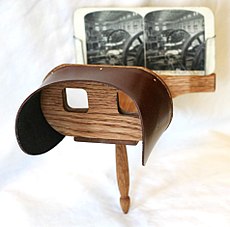The invention of photography early in the 19th Century incorporated advances in optics and chemistry to allow the instantaneous fixation of the camera obscura's image. That technological breakthrough did not spell the instant doom of the arts of painting a drawing as was initially feared, but it did take over those aspects of image making concerned primarily with the accurate portrayal of scenes and objects where fidelity of detail and perspective was of utmost importance.
The production of 3D (stereoscopic) photographic images began very soon after photography was invented, and by the end of the 19th Century there was a huge market for 3D photographic imagery produced with double lens cameras and viewed with simple hand-held binocular devices which allowed the optical fusing of two images into a single photographic representation with a startling illusion of depth. Most such images were produced and consumed for their educational and entertainment values. However, there were also some practical and scientific benefits flowing from the technology such as in its use in aerial photography.
| With 3D graphics, this NOVA film reveals how the Allies used special aerial photos to deal a dire blow to the Nazi rocket program |
Moving images in 3D color hit the big screen with a splash in the 1950s. Audiences were equipped with cardboard-framed glasses with polarized plastic lenses which merged the images from two projectors which seemed to thrust viewers into the midst of the action. In the films coming out of the 3D studios of that era, the novelty factor generally outstripped other production and literary values. Projection quality was difficult to maintain given the state of the technology, and interest in producing and viewing 3D films nosedived after a couple years of this first big Hollywood effort in the stereographic realm.
The development of 3D moving pictures continued on after the 1950's in specialized venues such as those provided by IMAX and Disney presentations in the 1980s and 1990s. By the beginning of the 21st Century, the industry started to ramp up again with many new productions taking advantage of advances in computer technology and digital image processing. The highpoint of this latest phase was realized in 2009 with the release of the science fiction film, Avatar. While that film was wildly successful, the industry soon took a downward turn again, possibly in a large part due to the world-wide economic collapse. A parallel effort to bring 3D technology into home video presentations also began to fizzle at the same time.
While 3D in entertainment venues has thus experienced what seems to be one of its regular downturns, other 3D applications are still being developed at a great rate, with big and small players exploiting the fact that computer processing capacity continues to come close to obeying the Moore's Law doubling prediction every two years. The big successes have been registered by applications with everyday utility like the on-line 3D maps provided by Google which offer vast, detailed coverage along with putting complete interactive control into users' hands.
3D modelling in design applications got a big boost from computer advancements which was initially capitalized on by big software companies like Autodesk. Google also got in on the act for a time with its 3D drawing program, Sketchup. However, it is noteworthy that Google recently sold off Sketchup to Trimble. That step away from this area of 3D image production may indicate a recognition of the fact that automated image capture and processing capabilities have caught up to older laborious manual processes and which can now produce 3D imagery very quickly and with a considerable level of sophistication.
Google's support of the Sketchup 3D modeling program was mainly aimed at giving a tool to a vast army of volunteers for producing 3D models of buildings which could be incorporated into Google Maps and Google Earth. Now, however, some small start-ups have demonstrated the possibility of producing very good 3D architectural models using camera-equipped drones and image-processing algorithms which can produce good models in a fraction of the time required by older manual drawing programs. It is not hard to imagine that Google may be considering the possibility of augmenting its fleet of camera-wielding mapping vehicles with airborne drones.

No comments:
Post a Comment